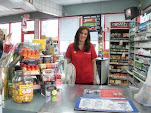C-stores are also known a corner stores, groceries, mom & pop stores, gas marts, bodegas, convenience stores, party stores, etc. Whatever they are called, you can be sure that they will have plenty of what you are looking for when you run out of batteries, snacks, cigarettes, ice, tape, tylenol..you get the idea.
Mr. Checkout Distributors is in the business of servicing these retail outlets with general merchandise, health & beauty care items, snacks, phonecards, sunglasses and more. Call Bob 561-367-0076 if you are a wholesaler looking to get your products into a c-store or an entrepreneur wanting to get into the wholesaling business.
"NACS defines convenience store as: ‘… a retail business with primary emphasis placed on providing the public a convenient location to quickly purchase from a wide array of consumable products (predominantly food or food and gasoline) and services.’
"There are six convenience store formats, as identified by a National Association Convenience Store (NACS) research report, as prepared by Gene Gerkle of Gerkle & Associates, Inc.
"Kiosk—This format is less than 800 square feet and is intended to provide some additional revenue beyond gasoline sales… This store sells only the fast-moving items found in traditional convenience stores (tobacco, beverages, snacks, and confectioneries)…Store sales may be only about ten percent of revenues in such locations…
"Mini Convenience Store—This store format, usually 800 to 1,200 square feet in size, is extremely popular with the oil companies, and the emphasis is on gasoline sales. However, in such locations, the owners view store sales as an important part of the revenue and margin picture…..
"Limited Selection Convenience Store—These stores, which range from 1,500 to 2,200 square feet, are becoming more numerous. They are often affiliated with oil companies and are in the size range of a converted two-bay service station…They differ from the ‘mini convenience store’ in a broader product mix and grocery offering…. Also, simple foodservice…may be offered...
"Traditional Convenience Store—Most of the original convenience stores fall into this category. They are about 2,400 to 2,500 square feet in size and offer a product mix which includes dairy, bakery, snack foods, beverages, tobacco, grocery, health and beauty aids, confectionery, and perhaps prepared foods to go, fresh or frozen meats, gasoline, various services, and limited produce items…. Such operations are
normally owned by convenience store chains, but oil companies have also built or acquired stores of this size..
"Expanded Convenience Store —Growth is occurring in the number of stores in the 2,800 to 3,600 square feet range. Such stores can accommodate … additional grocery products or room for significant fast food operations and seating … taking advantage of the niche which has developed as supermarkets increasingly move above the 40,000 square foot range…. A greater percentage are using the space to take advantage of the high profit margins in fast food….
"Hyper Convenience Store— These are very large stores (4,000 to 5,000 square feet) that usually offer an array of products and services arranged in departments. For example, such stores may offer variations such as a bakery, a sit-down restaurant area, or a pharmacy. Many of these locations
Wednesday, February 18, 2009
Subscribe to:
Comments (Atom)
